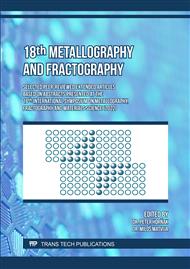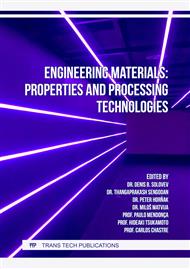p.41
p.53
p.64
p.74
p.84
p.90
p.96
p.102
p.108
Processing and Mechanical Properties of (Hf-Ta-Zr-Nb-Ti)C
Abstract:
The influence of the processing route on the microstructure characteristics and mechanical properties of high-entropy carbides was investigated. The experimental materials were prepared by a combination of ball milling and spark plasma sintering at the temperature of 2100 °C. The effect of sintering time (5 min, 10 min, and 20 min) on the microstructure development and properties of the investigated systems has been studied. The microstructure analysis was performed using scanning electron microscopy + EDAX analysis on the polished surfaces. Nanoindentation was used for the nano-hardness and Young’s modulus measurements. Micro-hardness was measured using Vickers method and indentation method using a Vickers indenter was used to determine the indentation fracture resistance – fracture toughness. The measured grain size values were in the range from 5 µm to 14 µm. The nano-hardness values changed from 36 GPa to 39 GPa and the indentation modulus of elasticity from 558 GPa to 577 GPa, respectively. The measured micro-hardness values were in the range from 18.93 GPa to 21.95 GPa and the indentation fracture resistance changed from 2.70 MPa.m1/2 to 3.50 MPa.m1/2, respectively.
Info:
Periodical:
Pages:
84-89
Citation:
Online since:
March 2023
Price:
Сopyright:
© 2023 Trans Tech Publications Ltd. All Rights Reserved
Share:
Citation:



